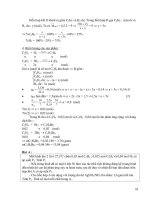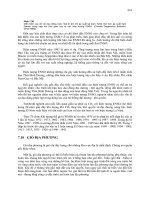Basic Geotechnical Earthquake Phần 9 pps
Bạn đang xem bản rút gọn của tài liệu. Xem và tải ngay bản đầy đủ của tài liệu tại đây (792.48 KB, 16 trang )
118 Basic Geotechnical Earthquake Engineering
For compliance with the serviceability limit state performance provisions, the simple
linear stress/strain relationships of materials are needed. These are the conventional parameters
used to assess the structural resistance to other loads. Assuming that the structural system
remains predominantly elastic, damage avoidance can reasonably be expected and compliance
can be assured. Simple elastic engineering models can be used to ascertain building response
in these conditions. Consequently, for concrete and masonry structures, the cracked sectional
properties are appropriate for the serviceability limit state, although significant yield of the
reinforcing steel (and the subsequent retention of wide residual cracks) is to be avoided.
For compliance with the ultimate limit state performance provisions, the post-elastic
response of the structure needs to be considered. This includes large post-elastic member
deformation (Fig. 11.1). Often traditional engineering models break down at this stage.
There is thus little to be gained by using highly sophisticated engineering modeling techniques
to demonstrate compliance with the ultimate limit states criteria unless there is a high degree
of confidence that the relationship between the elastic and inelastic structural response is
realistic. The simple elastic stress/strain relationships and the elastic engineering models used
to ascertain the load distribution between members within the structural system no longer
apply. It is to address this particular post-elastic response condition, being the primary objective
of good earthquake engineering design, that the principles of capacity design of structures
were developed and subsequently introduced.
11.4 EARTHQUAKE DESIGN LEVEL GROUND MOTION
A fundamental parameter contained within all earthquake loading standards is the
earthquake induced ground motion. This has to be used for design. This is generally prepared
by seismologists and geotechnical engineers. It is typically presented to the structural designer
in three components. They are the elastic response of the basement rock (usually as acceleration
spectra), the relative seismicity at the site (commonly presented as a suite of zonation maps),
and a modification function which is applied to the motion at bedrock beneath the site to
allow for near surface soil conditions (presented as either a simple amplification factor or as
a more complex soil property related function).
11.4.1 Elastic Response Spectra
Engineers traditionally have used acceleration response spectra to represent the motion
induced by the design earthquake. These spectra are generally presented as a response function
(acceleration, velocity or displacement) against the response period of a single-degree-of-
freedom oscillator (refer Fig. 11.2). Spectra are developed by calculating the response of a
single mass oscillator (usually with 5% critical damping present) to the design level earthquake
motion. Engineers traditionally have shown a preference for acceleration spectra, since the
resulting coefficient, when multiplied by the seismic mass, results in the lateral base shear for
the building. In Australia, and the uniformed building code used in the western USA, these
spectra are presented as a simple uniform coefficient followed by an exponential decay. The
New Zealand Loadings Standard prescribes an elastic response spectrum, derived using a
uniform risk approach, for each soil class. The modern trend as indicated by the European
Earthquake Resistant Design of Buildings 119
Earthquake Standard and also in the proposed National Earthquake Hazard Reduction Programme
(NEHRP) specification is to acknowledge that the response spectra is building period dependent.
This is achieved by publishing the design spectra in parametric form. In parametric form, the
ordinates of each parameter and the characteristics of the curve between them are read from
a series of seismic zonation maps of the region.
Fig. 11.2 A form of parametric acceleration response spectrum (Courtesy: )
11.4.2 Relative Seismicity
The current generation of earthquake loading standards uses a single seismic zonation
map. The map has iso-seismal contours to represent the relative seismicity between locations.
An example of one for New Zealand is shown in Fig. 11.3. The product of the zone factor,
Z, and the lateral acceleration coefficient derived from the design spectrum is used for
design. The next generation of earthquake loading standards are expected to specify spectral
acceleration as a function of the response period. They will also design event return period.
The simple linear scaling of a standard spectral shape will no longer be acceptable. Instead
we may expect, for example, a suite of three series of maps to reflect different probabilities
of exceedance (0.05 (20 year return period) 0.002 (500 year return period) and 0.0005 (2000
year return period)). Each set will comprise 4 maps each with spectral ordinates for periods
of perhaps T = 0, T = 0.2 seconds, T = 1 second and T = 2.5 seconds. The complete suite
may therefore comprise 12 regional maps which will enable the development of different
shaped elastic response spectra for different return periods.
This approach is likely to have significant impact on regions of low to moderate
seismicity. Reference to Fig. 11.4 indicates that while, as expected, the peak ground acceleration
is much higher in high seismicity regions than it is in low seismicity ones (ratio of 3.5:1).
The differential is markedly reduced as the probability of exceedance increases (2:1 for
0.0005 probability of exceedance) with the PGA being approximately equal to that of the
normal design event within a high seismicity area. It is likely that important key facilities
of the future will be required to survive earthquakes with exceedance intervals of this
order. The design requirements may well be quite similar regardless of regional seismicity
in such events.
120 Basic Geotechnical Earthquake Engineering
Fig. 11.3 Typical seismic zonation map (interpolation between iso-seismals is acceptable)
(Courtesy: )
Fig. 11.4 Variations of PGA against probability of exceedance with seismicity
(Courtesy: )
11.4.3 Soil Amplification
Earthquakes are usually initiated by rupture over a fault rupture plane. They are often
deep within the earth’s mantle. The ground motion experienced on the surface results from
the transmission of energy waves released from that bedrock source. It is transmitted first
through bedrock and then undergoes significant modification by soil layers as the energy
waves near the earth’s surface. Typically rock sites experience high short period response but
more rapid decay. Thus, short duration high intensity motion may be expected in such locations.
Earthquake Resistant Design of Buildings 121
Conversely soft soils, particularly when they extend to moderate depths (>50 metres) are
likely to filter out some of the short period motion. Usually longer period response is amplified,
particularly in cases where the soil mass has a natural period similar to the high energy
component of the earthquake. While such resonance effects can be taken into account when
site specific spectra are being developed, it is usually impractical to include such effects in
a loading standard. Soft soil response spectra have a flatter, broader plateau (refer Fig. 11.5).
Fig. 11.5 Typical spectral response curves modified for soil effects (Courtesy: )
11.5 DERIVATION OF DUCTILE DESIGN RESPONSE SPECTRA
Most modern earthquake design standards acknowledge the fact that buildings will experience
damage when they are subjected to severe earthquake attack. Attempts are made to quantify
the post-elastic capacity of different building type as well as material types. This is achieved
by including some form of ductility based adjustment factor. This has the effect of reducing
the elastic response coefficient down to a more convenient level. Below this level, elastic
response with little or no damage is expected. However, beyond this level, some damage is
accepted while collapse avoidance is to be assured.
Fig. 11.6 Basis for translation of elastic response spectra to inelastic design spectra
(Courtesy: )
Earthquake standards differ in how they translate the elastic response spectra derived
for the site into inelastic spectra which can be used as the basis for structural design. This
122 Basic Geotechnical Earthquake Engineering
includes both the seismic zonation factor and the local soil factors The two most common
methods are to use a combination of structural ductility and structural performance factors.
Within the New Zealand Loadings Standard, this is a combination of the ductility factor, µ,
and the structural performance factor, Sp. The European Earthquake standard, combines
these as a structural behaviour factor, q. The earthquake standards of Australia and the UBC
used in the western USA use a structural response factor, R
f
. Both q and R
f
are period
independent. Consequently, they are direct scaling factors of the site response spectra. The
various inelastic response spectra published within the New Zealand Standard introduce
period dependency with equal energy concepts being applied to short period structures as
well as equal displacement to long period ones. Furthermore, there is a transition zone in
between (refer Fig. 11.6). For very long period structures, a constant displacement response
can be expected.
11.6 ANALYSIS AND EARTHQUAKE RESISTANT DESIGN PRINCIPLES
11.6.1 The Basic Principles of Earthquake Resistant Design
Earthquake forces are generated by the dynamic response of the building to earthquake
induced ground motion. This makes earthquake actions fundamentally different from any
other imposed loads. Thus the earthquake forces imposed are directly influenced by the
dynamic inelastic characteristics of the structure itself. While this is a complication, it provides
an opportunity for the designer to heavily influence the earthquake forces imposed on the
building. Through the careful selection of appropriate, well distributed lateral load resisting
systems, the influence of many second order effects, such as torsional effects, can be minimised.
Furthermore, by ensuring the building is reasonably regular in both plan and elevation,
significant simplifications can be made to model the dynamic building response.
Fig. 11.7 Loading pattern and resulting internal structural actions (Courtesy: )
Most buildings can be reasonably considered as behaving as a laterally loaded vertical
cantilever. The inertia generated earthquake forces are generally considered to act as lumped
masses at each floor (or level). The magnitudes of these earthquake forces are usually assessed
Earthquake Resistant Design of Buildings 123
as being the product of seismic mass (dead load plus long-term live load) present at each
level and the seismic acceleration generated at that level. The design process involves ensuring
the resistance provided at each level is sufficient to reliably sustain the sum of the lateral
shear forces generated above that level (refer Fig. 11.7).
11.6.2 Controls of the Analysis Procedure
A schematic of the earthquake design process is presented in Fig. 11.8. The essential
features of the process are as follows:
1. Structural designers are usually given the site location. They are also provided with
intended occupancy of the building.
2. The national building code normally includes the requirements for the following:
(i) the design philosophy acceptable for buildings (Limit States or Working Stress
Design)
(ii) the performance objectives for the prescribed occupancy class.
(iii) the structural importance classification and
(iv) the proportion of live load considered to be present during a major earthquake.
3. Derive the peak ground acceleration (i.e. elastic response spectrum for T=0) for the
design intensity earthquake ground motion. The derivation is from the consideration
of the seismicity of the region, modified by the near surface soil modification factor
(refer Section 11.4). The seismicity of the region is selected to match the design
event return period
4. Select a suitable structural configuration. This selection is with consideration for the
following parameters:
(i) the characteristics of the various lateral load resisting structural forms available.
(ii) the desirability of matching the strength and stiffness of the structural frame to
that expected under the dynamic loading of the building itself. It implies strength
and stiffness decreasing uniformly up the height of the building. However, this
will influence the distribution of the base shear over the building height. Consequently,
it may dictate the method of analysis acceptable for the building to avoid its
collapse.
(iii) the desirability of a regular building plan with well balanced lateral load resisting
systems. It will be evenly distributed about the building plan. Irregular plan will
usually require three dimensional analysis. Furthermore, it may experience severe
torsional response.
(iv) the material from which the structural system is to be constructed. Consequently,
the post-elastic curvature (ductility) which can be accommodated through specific
detailing.
5. Determine the level of design required. (Note: There will be many normal occupancy
buildings in regions of low seismicity. They do not require any specific earthquake
resistant measures to be introduced. Other levels of design involve a) simply tying
124 Basic Geotechnical Earthquake Engineering
Fig. 11.8 Schematic of the earthquake design procedure (Courtesy: )
Earthquake Resistant Design of Buildings 125
elements together. This will ensure a continuous, rational load path which exists for
earthquake induced lateral loads, or, b) detailed analysis of the building subjected
to both gravity induced loads and a rationally derived lateral loading pattern. It will
reflect the earthquake generated forces.
6. Ascertain the fundamental period of response of the building. It is based on assumed
member of sections and properties. (Note: Several empirical formula are available as
the basis for determining the fundamental period of buildings. It is generally preferable
to assess the building response based on a realistic distribution of seismic mass at
each level up the building).
7. Ascertain from the horizontal regularity of the structure, whether a simple two dimensional
or the more complex three dimensional analysis model required.
8. Ascertain by consideration of the vertical regularity of the structure, whether the
structural response will be dominated by the first mode response of the structure in
which case the simplified equivalent static design procedure can be used. Otherwise,
because of vertical structural irregularity, multi-modal analysis will be required to
enable the base shear distribution to be established.
9. If equivalent static analysis is acceptable then:
(i) calculate the design level base shear force. It is obtained from the product of the
seismic mass and the lateral force coefficient which are derived from the inelastic
response spectra.
(ii) distribute the base shear to each level of the building and between lateral load
resisting systems. This is done in accordance with horizontal and vertical regularity
of the structure.
(iii) use elastic analysis techniques to determine actions induced on members from
load combinations which include earthquake forces.
10. If multi-modal analysis is required then:
(i) ascertain the period and deformed shape for each mode.
(ii) ascertain the contribution of each mode from the base shear of each mode,
distributed between levels according to each mode shape. It is derived from the
elastic response spectra lateral acceleration at each respective modal period.
(iii) combine the contribution from each mode using an appropriate modal combination
technique.
11. Scale the elastic deformation obtained from the analysis to allow for post-elastic
deformations. Furthermore, check that the overall deformation of the structure as
well as the inter-storey drift limits are within acceptable limits.
11.6.3 The ‘Conventional’ Earthquake Design Procedure
The conventional engineering design approach is to use the actions for members derived
from the above elastic analysis. It is used as the basis for determining the dimensions and
structural capacity. Significant changes in dimension will affect the building stiffness. It may
require re-analysis. The resulting sizes are then checked against those assumed during the analysis.
126 Basic Geotechnical Earthquake Engineering
Earthquake design has three important distinctions from other loadings. Firstly there
is the acceptance that damage to both non-structural and some structural elements will occur.
However, collapse is to be avoided. Secondly, earthquakes are highly variable dynamic events
which designers tend to simplify into a set of quasi-static lateral loads. This approach enables
relatively simple analysis and design. However, it noticeably departs from reality. It is therefore
important to build into the structure a degree of toughness or robustness which will avoid
the development of undesirable collapse mechanisms. Thirdly, although there is geological
and seismological understanding of how earthquakes are initiated and how the energy release
mechanisms translate into surface ground motion, earthquakes still inherently contain a higher
level of uncertainty.
Several modern earthquake design standards, particularly those which apply to regions
of moderate or high seismicity, permit designers to make special provisions to accommodate
the anticipated level of damage. They also take additional measures to ensure the collapse
prevention mechanisms are robust enough to avoid overloading. This can be achieved when
the designer takes control of the structure, and dictates which and where post-elastic mechanisms
are to occur. The designer should also ensure the post-elastic demands are within levels
acceptable for the material being used. Furthermore, undesirable possible collapse mechanisms
are to be suppressed within the elements themselves.
11.7 EARTHQUAKE RESISTANT STRUCTURAL SYSTEMS
Three types of earthquake resistant structural systems are generally available.
11.7.1 Moment Resisting Frames
Moment resisting frames typically comprise floor diaphragms supported on beams which
link to continuous columns. The joints between beam and columns are usually considered to
be ‘rigid’. The frames are expected to carry the gravity loads through the flexural action of
the beams as well as the propping action of the columns. Lateral loads, imposed within the
plane of the frame, are resisted through the development of bending moments in the beams
and columns. Framed buildings often employ moment resistant frames in two orthogonal
directions. The column elements are common to both frames in such cases.
Moment resisting frames are well suited to accommodate high levels of inelastic deformation.
When a capacity design approach is employed, it is usual to assign the end zones of the
flexural beams to accept the post-elastic deformation expected. Furthermore, the column
members are designed such that their dependable strength is in excess of the over-strength
capacity of the beam hinges. This ensures that they remain within their elastic response range
regardless of the intensity of ground shaking due to earthquake. Moment resisting frames
are, however, often quite flexible. When they are designed to be fully ductile, special provisions
are often needed to prevent the premature onset of damage to non-structural components of
the structure.
11.7.2 Shear Walls
The primary function of shear walls is to resist lateral loads. However, they are often
Earthquake Resistant Design of Buildings 127
used in conjunction with gravity frames and carry a proportion of gravity loads also. Shear
walls fulfil their lateral load resisting function by vertical cantilever action. By reference to
Fig. 11.3 it can be seen that both the shear force and bending moment generated by the
earthquake actions increase down the height of the building. Since shear walls are generally
both stiff and can be inherently robust, it is practical to design them to remain nominally
elastic under design intensity loadings. This is particularly true in regions of low or moderate
seismicity. Under increased loading intensities, post-elastic deformations will develop within
the lower portion of the wall. This portion is generally considered to extend over a height of
twice the wall length above the foundation support system. However, it can result in difficulties
in the provision of adequate foundation system tie-down to prevent uplift. Consequently, the
design of rocking foundations is common with shear walls. Good post-elastic response can
be readily achieved within the region of reinforced concrete or masonry shear walls. It is
achieved through the provision of adequate confinement of the principal reinforcing steel as
well as the prohibition of lap splices of reinforcing bars.
Shear wall structures are generally quite stiff. Inter-storey drift problems are rare and
generally easily contained. The shear wall tends to act as a rigid body rotating about a plastic
hinge. The hinge forms at the base of the wall. Overall structural deformation is thus a
function of the wall rotation. Inter-storey drift problems which do occur are limited to the
lower few floors. A major shortcoming with shear walls within buildings is that their size
provides internal (or external) access barriers. It may contravene the architectural requirements.
This problem can be alleviated by coupling adjacent more slender shear walls. The coupling
beams then become shear links between the two walls. Their careful detailing can provide a
very effective, ductile control mechanism.
11.7.3 Braced Frames
Frames employing diagonal braces as the means of transmitting lateral load are common
in low-rise and industrial buildings. The bracing elements are typically inclined axially loaded
members which traverse diagonally between floors and column lines. They are very efficient
in direct tension. Furthermore, they may also be detailed to accept axial compression. However,
suppression of compression buckling requires careful assessment of element slenderness.
Major shortcomings of braced systems are that their inclined diagonal orientation often
conflicts with conventional occupancy use patterns, either internally, across windows or external
fabric penetrations. Furthermore, they often require careful detailing to avoid large local
torsional eccentricities being introduced at the connections with the diagonal brace being
offset from the frame node. A variation on this form of lateral resisting system is the eccentrically
braced frame. This system employs a horizontal ‘K’ form of bracing. The central zone of the
‘K’ acts in flexure as the tension/compression legs of the brace drive the beam element into
direct flexure.
11.8 THE IMPORTANCE AND IMPLICATIONS OF STRUCTURAL REGULARITY
Most Standards outline certain provisions relating to the vertical regularity of the
structure, as well as the plan regularity. These usually apply to the appropriateness of several
128 Basic Geotechnical Earthquake Engineering
assumptions. These assumptions are implicit in the distribution pattern of the loading as well
as the torsional effects.
11.8.1 Vertical Regularity
Ideally the capacity of the structure should follow the shear and bending moment
pattern of the structure shown in Fig. 11.3. Substantial departures from this ideal typically
result in the onset of premature post-elastic deformations. They are often concentrated at
over one level. When this occurs, elements within the one level degrade. It attracts additional
post-elastic deformation. Consequently, a soft-storey mechanism develops with collapse often
being the inevitable result.
The vertical regularity check is intended to avoid abrupt changes in overall strength as
well as the stiffness at any particular level. Where such provisions are not met, more detailed
analysis will be required. Objective of such analysis is to ensure that post-elastic deformation
capacity at each level can be met without unacceptable loss of strength. Furthermore, post-
elastic deformation demands in excess of their capacity should also be met.
It is wise to avoid abrupt curtailment of reinforcing steel at one level of a reinforced
concrete frame or substantive changes in a column section. It is better to introduce such
changes gradually, over several floors. This allows a smooth transition between sections to
develop. Obviously it is undesirable to curtail shear walls above their base, since it induces
a very real potential for soft-storey development.
11.8.2 Horizontal Regularity
The random, three dimensional motions generated by earthquakes is usually simplified
into two transverse orthogonal components. The vertical response is typically ignored. The
transverse dynamic response may also introduce twisting and torsional effects. This could
either directly be as a function of the input ground motion, because of variations in the
spatial distribution of seismic mass, or because of the structure being irregular in plan.
Measures employed to counter these effects typically involve distributing the lateral
load resisting systems about the building plan. Furthermore, attempt is made to limit the plan
profile to being reasonably regular and compact. Most modern earthquake loading standards
require the designer to assess the Centre of Rigidity (CoR) of the structural system. The
centre of mass (CoM) of the uniformly distributed seismic mass should also be assessed. The
eccentricity is typically increased by 10% of the building width. This is done to allow for
unexpected variations in torsional effects with the magnitude of the resulting torsional action
increasing accordingly. The torsional action is the product of mass and linear eccentricity
between CoR and CoM. Such approximations tend to be based upon the response of the
structure within the elastic response domain. However, they may provide little security against
collapse once the deformations have progressed into the inelastic domain. (Paulay, 1997), has
recently proposed an elegant means of directly addressing post-elastic torsional effects. He
postulates that the post elastic torsional demand can be met, satisfied and indeed controlled
by rigorous detailing of lateral load resisting elements. This ensures that their displacement
ductility demands are met. Provided this is achieved, the effects of torsion are readily accommodated.
Earthquake Resistant Design of Buildings 129
The preferred method of minimising torsional effects is to select floor plans which are
regular and reasonably compact. Wide separation of horizontal lateral load resisting systems
is encouraged. Plan forms with re-entrant corners such as ‘L’ and ‘T’ plan layouts should be
avoided. If these plan forms are dictated by other constraints, seismic separation joints
should be introduced between rectangular blocks. Such joints must be designed to accept the
post-elastic dynamic response of the building parts. This may be responding with disparate
phases. Contact and hammering between blocks is also to be avoided.
11.8.3 Floor Diaphragms
The floor system, in additional to supporting the live loads induced by the building
contents, can also be designed as a floor diaphragm. This floor diaphragm links the lateral
load resisting systems at each level. Other horizontal loading mechanisms such as horizontal
trusses or deep beams can be used where the floor system is interrupted by penetrations or
openings. The diaphragm action of floors is often taken for granted during design. It is
important that designers allow for the concentrations of horizontal stress within the floor
diaphragm around openings. Care should also be taken to ensure that the interconnection
between the floor diaphragm and the vertical lateral load resisting system is sufficiently
robust. This helps to transmit the required shear between elements. Precast flooring systems
using slender cast in situ toppings can be quite vulnerable in these conditions.
11.9 METHODS OF ANALYSIS
Earthquake engineering design techniques have advanced greatly. This has occurred
with the advent of modern computing techniques. The prudent designer, however, is wise not
to lose sight of the primary objective of earthquake design (i.e. collapse avoidance). Furthermore,
the level of uncertainty present in several of the key input parameters should also be taken
into account. Little may therefore be achieved by using highly sophisticated analysis techniques.
It has been concluded that the selection of regular building configurations and the application
of sound detailing principles are more likely to provide the required level of security against
collapse. On the other hand, detailed refinement of the analysis techniques will not be useful.
11.9.1 Integrated Time History Analysis
Integrated time history analysis techniques involve the stepwise solution in the time
domain of the multi-degree-of-freedom equations of motion. These equations represent the
actual response of a building. It is the most sophisticated level of analysis available to the
earthquake engineer. Its solution is a direct function of the earthquake ground motion, which
are selected as the input parameter for the specific building. Such records are seldom available
directly for a given site. On the other hand, either synthetic ground motion or modified real
free-field records are generally used. The modelled representation of the structure itself is
required to realistically represent both the elastic and post-elastic response characteristics of
the building. However, this detail information is seldom available when commencing the
design process. Consequently, this analysis technique is usually limited in its application to
checking the suitability of assumptions made during the design of important structures.
130 Basic Geotechnical Earthquake Engineering
11.9.2 Multi-modal Analysis
Multi-modal analysis is an elastic dynamic response analysis technique. This involves first
the determination of the structural response of each mode of vibration of the building. Then
it is followed by the combination of the resulting forces for each significant response mode.
For such assessments it is usually convenient to consider the structural mass to be
concentrated at each floor level. This results in one degree of freedom for each floor provided
torsional effects are ignored. When the building is torsionally susceptible, lateral and torsional
response will need to be considered. Consequently, the number of possible response modes
will be doubled. The procedure involves determining both the response period and the mode
shape. The determination of the lateral shear coefficient for each response mode (from the
design spectra using the modal period) and the distribution of the resulting base shear
according to the response shape at each floor is also involved. The contribution of each
response mode is then combined with an allowance being made for the time variance between
different response modes. Thus a square-root-sum-of-squares (SRSS) method of combining
lateral forces is generally used. Other combination methods, such as the complete quadratic
combination (CQC) method may be required where the response modes are close together.
A static analysis using the resulting equivalent forces is also used as the basis for determining
the forces and displacements of the overall structure.
This technique takes into account allowance for the true response characteristics of the
building. However, it should be remembered that it is still assessing the structural response
while it remains elastic. Collapse avoidance, with the implied onset of controlled damage (i.e.
post-elastic deformations), requires many assumptions to be made to arrive at the inelastic
response. In addition many of the structural member properties needed for the analysis are
unknown. They can be known only after a preliminary analysis has been undertaken. Consequently,
the sophistication of the model often adds little to the final design.
11.9.3 Equivalent Static Analysis
The equivalent static analysis procedure is also essentially an elastic design technique.
However, some consideration of the post-elastic response enters into the selection of the
determination of the lateral force coefficient. It is, however, simple to apply the multi-model
response method. The implicit simplifying assumptions are arguably more consistent with
other assumptions implicit elsewhere in the design procedure. The equivalent static analysis
procedure involves the following steps:
1. Estimate the first mode response period of the building. This is obtained from the
design spectra.
2. Use the specific design response spectra to determine the lateral base shear of the
complete building. This should be consistent with the level of post-elastic (ductility)
response assumed.
3. Distribute the base shear between the various lumped mass levels. It is usually based
on an inverted triangular shear distribution of 90% of the base shear. 10% of the
base shear is being imposed at the top level to allow for higher mode effects.
Earthquake Resistant Design of Buildings 131
4. Analyse the resulting structure under the assumed distribution of lateral forces.
Furthermore, determine the member actions and loads.
5. Determine the overall structural response. Particularly regarding the inter-storey drifts
assessed for the elastically responding structure. For the assessment of the post-
elastic deformation, design standards typically magnify the elastic deformed shape by
the structural ductility. This helps to determine the overall maximum deformation.
Usually it is at the roof level. Introduction of a non-linear response profile to allow
for local rotation at plastic hinge zones is often required when determining the inter-
storey drifts.
Home Work Problems
1. Comment on key material parameters for effective earthquake resistant design for compliance
with:
(i) serviceability limit state
(ii) ultimate limit state
2. Explain about components of earthquake design level ground motion.
3. Write short note on ductile design response spectra.
4. What are the types of earthquake resistant structural systems? Briefly explain about them.
5. Comment on earthquake engineering design techniques.
132 Basic Geotechnical Earthquake Engineering
132
Acharrya, S.K. 1999. Natural Hazards: Earthquakes and Landslides in India during the nineties
and mitigation strategy. Proc. Sem. on Earthquakes & landslides: Natural disaster mitigation,
Calcutta, pp. 5-13.
Ahmed, K. 1998. Special report of earthquakes. Down to Earth, December 31 issue, pp. 22-
23.
Ambraseys, N., and D. Jackson, (2003), A note on early earthquakes in northern India and
southern Tibet, Current Science, 84(4), 571-582.
Ambraseys, N., and R. Bilham, (2003a). Earthquakes in Afghanistan, Seism. Rev. Lett., 74(2),
107-123
Australian Building Codes Board. 1996. Building Code of Australia. CCH Australia for the
ABCB. Canberra.
Bapat, A. 1996. Creation of awareness about earthquakes- Case Histories. Prc. Int. Conf on
Disaster & Mitigation, Madras, Vol. 1, pp A1 1-3.
Bendick, R. and R. Bilham (1999) Search for buckling of the southwest Indian coast related
to Himalayan collision. In Himalaya and Tibet: mountain roots to mountain tops.
Bhagwan, N.G. and Sreenath, H.G. 1996. A seismic vulnerability reduction strategy for low
rise building construction. Int. Conf. on Disaster & Mitigation, Madras, Vol. 1, pp. A3
11-16.
Bilham, R. (1994). The 1737 Calcutta Earthquake and Cyclone Evaluated, Bull. Seism. Soc.
Amer. 84(5), 1650-1657.
Bilham. R., F. Blume, R. Bendick and V. K. Gaur (1998) Geodetic constraints on the
Translation and Deformation of India: implications for future great Himalayan earthquakes,
Current Science, 74,(3), 213-229.
Bilham, R., R. Bendick and K. Wallace (2003). Flexure of the Indian Plate and Intraplate
Earthquakes, Proc. Indian Acad. Sci. (Earth Planet Sci.),112(3) 1-14.
Chester et al., Journal of Geophysical Research, 1993
Cunny R.W. and Sloan R.C. (1961), “Dynamic loading machine and results of preliminary
REFERENCES
References 133
small-scale footing tests” A.S.T.M. Symposium on Soil Dynamics, Special Technical Publications,
No. 3-5 pp 65-77.
Das Gupta, S.K. 1999. Seismic hazard assessment: local geological effects of strong ground
motion. Proc. Sem. on Earthquakes and Landslides: Natural disaster mitigation, Calcutta,
pp. 44 - 51.
Das, T. and Sarmah, S.K. 1996. Earthquake expectancy in northeast India. Int. Conf. on
Disaster & Mitigation, Madras, Vol. 1, pp. A1. 14-18.
Day R. W. (2002) Geotechnical Engineering Handbook, Mcgraw-Hill Handbooks
Department of Science & Technology, Govt. of India (1999). Earthquake Researches in India.
P. 13.
Ed. A. Macfarlane, R. Sorkhabi, and J. Quade. Geological Society of America Special Paper
328. 313-323.
Gupta, H.K. 1999. Big quakes more a norm than exception. Times of India, September 19,
1999, P. 12.
Iyengar, R. N., 1994, Earthquake History of South India, The Hindu, Jan. 23.
Katsumi, Maraya M.M. and Miteuru T. (1988), “Analysis of gravel drain against liquefaction
and its application to design” IXth WCEE, Tokyo, Vol. III, pp 249-254.
Kayal, J.K. 1998. Seismicity of northeast India and surroundings- development over the past
100 years. Jour. Geophysics, XIX (1), pp. 9-34.
Khan, K., (1874). Muntakhab-ul Lubab, M.H., Bibl. India Series, Calcutta.
Khatri, K.N. 1999. Probabilities of occurrence of great earthquakes in the Himalayas. Earth
& Planetary Sciences. 108 (2), pp. 87-92.
Kuwabara F. and Yoshumi Y. (1973), “Effect of subsurface liquefaction on strength of surface
soil” ASCE, JGE, Vol. 19, No. 2.
Lew M. (1984), “Risk and mitigation of liquefaction hazard” Proc. VIIIth WCEE, Vol. 1, pp
183-190.
Lyman A.R.N. (1942), “Compaction of cohesionless foundation soil by explosive” ASCE
Trans., Vol. 107.
Meyerhof G.G. (1951), “The ultimate bearing capacity of foundations” Geotechnique, Vol. 2,
No. 4, pp 301-331.
Meyerhof G.G. (1953), “The bearing capacity of footings under eccentric and inclined loads”
Proc. Third International Conf. Soil Mech. Foun. Engg., Zurich, Vol. 1, pp 440-445.
Nandi, D.R. 1999. Earthquake, earthquake hazards and hazards mitigation with special reference
to India. Proc. Sem. on Earthquake & Landslides: Natural disaster mitigation, Calcutta,
pp. 15-20.
New Zealand Government Print, 1992. Regulations to the Building Act, Wellington Oldham,
T., (1883), A Catalogue of Indian earthquakes, Mem. Geol. Surv. India, 19, 163 215,
Geol. Surv. India, Calcutta.
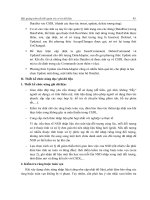
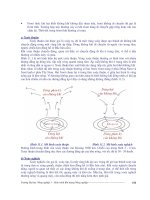
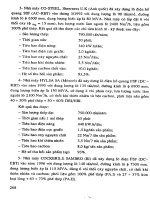
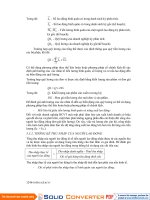
![[Tự Động Hóa] Hệ Mờ & NơRon - TS. NGUYỄN NHƯ HIỀN phần 9 ppsx](https://media.store123doc.com/images/document/2014_07/14/medium_kkl1405275684.jpg)
